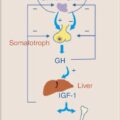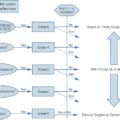Preamble
In contrast to other chapters in this volume, the emergency reviewed here arises from an external event. It is also different in the paucity of risk factors associated with a nuclear emergency. In fact, one could say that the only risk factor is living or spending time in the vicinity of an operating nuclear energy facility.
The goal of this chapter is to discuss how to avert the thyroid-related consequences of a radiologic emergency, not how to diagnosis and treat a medical emergency. Therefore, even though this chapter focuses on the role of potassium iodide (KI), it is important to remember that it is only one part in the response. Of equal or greater importance, depending on the circumstances, are evacuation and dietary measures, especially the control of the milk pathway (see later).
This chapter mainly emphasizes medically related issues. It is based on the authoritative guidelines from the following organizations: Center for Disease Control and Prevention (CDC), U.S. Food and Drug Administration (FDA), World Health Organization, American Thyroid Association, and U.S. Department of Health and Human Services ( Box 26.1 ). For the most part, this chapter is directed to the use of KI in the United States, since variations in other countries are minimal. The guidelines listed in Box 26.1 should be consulted for a wider geographic perspective.
Centers for Disease Control and Prevention
Potassium Iodide (KI) https://www.cdc.gov/nceh/radiation/emergencies/ki.htm
(Page last reviewed: 4/4/2018 [accessed 11/19/2019])
Content source: National Center for Environmental Health (NCEH), Agency for Toxic Substances and Disease Registry (ATSDR), National Center for Injury Prevention and Control (NCIPC)
U.S. Food and Drug Administration
Guidance. Potassium Iodide as a Thyroid Blocking Agent in Radiation Emergencies, 2001 https://www.fda.gov > media > download
Accessed 11/19/2019 https://www.fda.gov/drugs/bioterrorism-and-drug-preparedness/frequently-asked-questions-potassium-iodide-ki
Content current as of: 10/14/2016
Accessed 11/19/2019
World Health Organization
Iodine thyroid blocking Guidelines for use in planning for and responding to radiological and nuclear emergencies, 2017
Available at https://www.who.int/ionizing_radiation/pub_meet/iodine-thyroid-blocking/en/
Accessed 11/19/2019
American Thyroid Association
Leung AM, Bauer AJ, Benvenga S, et al. American Thyroid Association scientific statement on the use of potassium iodide ingestion in a nuclear emergency. Thyroid. 2017;27(7):865–877.
U.S. Department of Health and Human Services
Radiation Emergency Medical Management
Potassium iodide (KI)
Available at https://www.remm.nlm.gov/potassiumiodide.htm
Updated 6/26/2019
Accessed 12/8/2019
How Does Potassium Iodide Protect the Thyroid?
Many sources, including those directed to the general population, state that the protective effect of KI is a result of the dilution of radioactive iodine. Although this is correct and intuitively clear, dilution is not the only mechanism. The well-known (but incompletely understood) Wolff-Chaikoff effect may play an even more important role. , Two recent studies shed light on this incompletely understood phenomenon. , These studies, one using experimental studies in rats and the other using analytical methods (a systems biology approach), indicate that the thyroid is protected by the downregulation of the sodium-iodide symporter (NIS), thyroid peroxidase (TPO), and monocarboxylate transporter 8 (MCT8). KI ingestion thus limits radiation exposure to the thyroid by preventing radioiodine entry and organification.
What Are the Sources of Exposure to Radioactive Iodine?
The most likely source of exposure to radioactive iodine is from an accident at an operating nuclear power plant. A decommissioned or off-line nuclear facility does not retain significant amounts of 131 I, given its half-life of about 8 days. A “dirty bomb” usually refers to a conventional explosion with the aim of spreading radioactivity. Such a bomb could contain 131 I stolen from a medical facility (an unlikely occurrence), but the amount of 131 I exposure to any person would be very low. A 2019 episode in northern Russia, presumably related to a missile development accident, released radioactivity into the air, but the presence of radioactive iodine in the release has not been substantiated; nevertheless, local supplies of KI around the site were reportedly quickly sold out. Research reactors, academic or otherwise, are also subject to potential accidents. However, the amount of radioactive iodine from these potential sources, except in the immediate vicinity, is unlikely to reach the level where KI is advised.
KI is also used in the nuclear medicine setting. It is administered to protect the thyroid when a radioactive iodine–containing agent, such as 131 I-labeled MIGB (metaiodobenzylguanidine), is used for diagnostic or therapeutic purposes. (The recommended amounts and duration of administration are outside the scope of this chapter.)
Nuclear bombs are more complex. In the past, before the harmful effects of radiation were fully realized, inadequately protected facilities making fissionable materials were a source of environmental radioactive contamination (e.g., the Hanford, Washington reactors released an estimated 685,000 curies (Ci) of radioactive iodine into the atmosphere in the 1940s ), but this is no longer the case. Similarly, in the era of above-ground nuclear testing, radioactive iodine was released into the upper atmosphere. The two bombs used in 1945 over Hiroshima and Nagasaki exploded at high altitude, and the resulting radioactive iodine did not concentrate in a localized area.
What Are the Risks of Exposure to Radioactive Iodine?
The majority of what is known about the relationship between radiation exposure and thyroid cancer comes from studies of external radiation. The relationship between dose and the excess relative risk of thyroid cancer is essentially linear in the dose ranges that potentially occur after a nuclear power plant accident. , The lowest dose where there is a demonstrable risk of thyroid cancer is 50 mCi (5 rads). This dose limit informs the guidelines for the response to radioactive iodine exposure, as discussed below. At the higher thyroid doses typically experienced during many types of cancer therapy, the risk reaches a plateau, then subsides, but does not disappear. The risk rises over decades before decreasing, but never returning to background levels. In addition to dose, age at exposure is strongly related to risk, with children at much higher risk than adults. This also informs the KI guidelines, which emphasize that in the event of a radiation emergency the use of KI should be prioritized for children under the age of 18 and pregnant women.
Any doubt about the carcinogenic effects of radioactive iodine (predominantly 131 I) were dispelled in the aftermath of the Chernobyl accident. , Prospective studies conducted in Ukraine, Belarus, and the Bryansk Oblast of Russia have been largely concordant. A clinically important observation was that thyroid cancers could be evident as early as about 5 years after the exposure. It should be noted that several factors affected the outcome of the Chernobyl accident. Most of the region surrounding the site of the accident was, at the time of the accident, iodine insufficient. This would have enhanced the uptake of radioactive iodine into the thyroid and could have affected the clinical course of the subsequent thyroid cancers. Aggravating the effects of the accident was the delay in making the at-risk population aware of the accident and the delay in controlling the intake of radioactive iodine through the dietary pathway (especially though the milk pathway).
For many years, it was assumed that internal radiation was less carcinogenic than external radiation. Importantly for the development of the KI guidelines, the Chernobyl experience has called that view into doubt. The risk estimates (expressed as excess relative risk; ERR) and behavior over time for Chernobyl-related thyroid cancer are similar to those after external radiation exposure, so it is now likely that the effects are essentially the same. ,
Availability of Potassium Iodide in the United States
The seminal study of Blum and Eisenbud investigated the effectiveness of KI with respect to interval between radioactive iodine exposure and the time of KI ingestion. This publication led to the potentially amusing conclusion that the best time to take KI is before the accident. Subsequent events in Fukushima show why this cannot be considered humorous. In Fukushima, the major releases did not occur immediately after the accident began. Rather the major releases of radioactive elements, including iodine, began when explosions destroyed the reactor containment measures. In other words, there was time between the start of the accident and the start of major radioactivity releases into the atmosphere. Presumably, in future accidents, KI could be taken before exposure. The protective effect of KI falls rapidly. Some estimates are that protection is less than 50% at 8 hours , and other estimates is that protection at 8 hours is even less. ,
As a result of these time-related factors, it is widely accepted in the United States and internationally that to be effective, potassium iodide needs to be pre-distributed to people in the vicinity of operating nuclear power plants. An American Thyroid Association statement lists the factors supporting and opposing pre-distribution. In the United States, KI is pre-distributed to households within 10 miles of an operating nuclear power plant and to locations such as schools and hospitals within that limit.
Only FDA-approved KI products may be marketed legally in the United States. As of October 2016, the KI products that are FDA-approved and available are: iOSAT tablets (130 mg, from Anbex, Inc.), ThyroSafe tablets (65 mg, from Recipharm AB), ThyroShield oral solution (65 mg/mL, from Arco Pharmaceuticals, LLC), and Potassium Iodide Oral Solution USP (65 mg/mL, from Mission Pharmacal Company). Directions for preparing a KI solution from tablets, required to protect infants and very young children, are available. No prescription is needed to obtain KI. Other iodine-containing tablets can be found on the internet, including one with the dangerously named “Potassium Iodate Nuclear Anti-Radiation” pills. In addition to its lack of FDA approval, calling it an antiradiation pill can lead the unaware to tragically misguided decisions, for example, to remain in place when evacuation is preferable or mandated. The appellations “anti-radiation pills,” “anti-nuke tablets,” and similar ones are all too common. Potassium iodate is available in other countries.
The FDA-approved shelf life of KI is 7 years. If a state follows certain storage guidelines, the shelf life can be extended. For those whose only access is to KI tablets that have expired, it is safe to take them. The method for distributing KI within the 10-mile radius varies from place to place. There is little known about the effectiveness of pre-distribution of KI with respect to percent coverage and public awareness about proper KI storage and administration. In the United States, what little is known shows substantial shortcomings that need to be addressed. In France, it has been reported that 60% of eligible homes within 10 km of active nuclear reactors have obtained KI.
Guidelines for Use
Age and dose: The guidelines developed by the CDC regarding the radiation exposure above which KI is recommended are shown in Table 26.1 . There are age-specific thresholds because the susceptibility of the thyroid to develop cancer decreases markedly with age. In fact, for the oldest category, KI is advised only as a means to avoid hypothyroidism.






